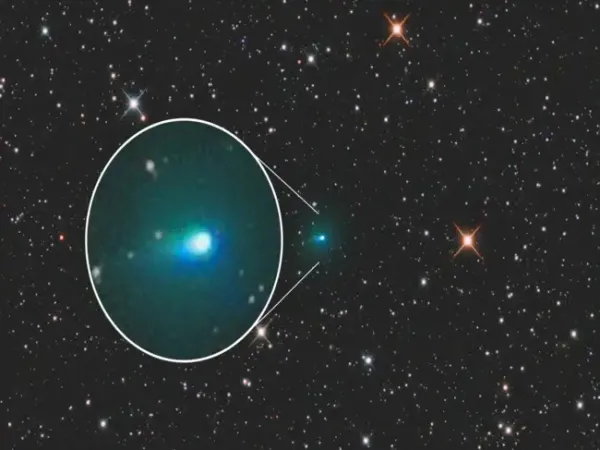It has been nearly two weeks since 3I/ATLAS reached its closest point to the sun, known as perihelion, but theories and speculations around the comet continued to keep the scientists intrigued with the ongoing latest developments linked to its shape, size, and origin. Now some fresh developments have surfaced about the interstellar object suggesting that more evidence has emerged to support the natural origin of comet 3I/Atlas.
Amid all the conspiracy theories, claims from scientists, and speculations, this interstellar object, the third known object from outside our solar system, is still a comet. According to WIRED, the most recent confirmation came from an observatory in South Africa that detected the first radio signal from 3I/Atlas.
What exactly is that mysterious radio signal
Is it really a radio signal or something else? The answer is no; the apparent signal isn't a radio signal like a transmission emitted by a spacecraft. It's instead a radio frequency pattern detected by MeerKAT, according to WIRED. MeerKAT is a radio telescope composed of 64 antennas, each with a diameter of 13.5 meters, operated by the South African Radio Astronomy Observatory.
What did MeerKAT detect?
According to researchers, the radio telescope detected "OH absorption was detected on the 1665 MHz and 1667 MHz lines." Specifically, MeerKAT detected lines of radio absorption by hydroxyl radicals, that is, OH molecules, a pattern that would be consistent with typical comet activity.
The lines appear as absorption because 3I/Atlas was very close to the sun, and the observing geometry favors absorption over emission. 3I/ATLAS reached its closest point to the sun on October 29, 2025. This point in its orbit is known as perihelion. At that time, it was approximately 203 million kilometers (126 million miles) from the sun.
The phenomenon was explained in WIRED. When comets reach their closest point to the sun, they sublimate ice into space and receive a greater amount of radiation. This also causes them to alter their trajectory. The hydroxyl radical (OH) has the ability to absorb or emit radiation at specific frequencies (such as the 1665 and 1667 MHz lines) due to transitions in its energy levels. These OH spectral lines have been detected in nebulae, comets, and star-forming regions.
3I/ATLAS Discovery
The NASA-funded ATLAS (Asteroid Terrestrial-impact Last Alert System) survey telescope in Rio Hurtado, Chile, first reported observations to the Minor Planet Center of comet 3I/ATLAS on July 1, 2025.
After being reported for the first time, observations made before the discovery were gathered from the archives of three different ATLAS telescopes around the world and Caltech’s Zwicky Transient Facility at the Palomar Observatory in San Diego County, California, according to the NASA website. These “pre-discovery” observations extend back to June 14, 2025.
How did the 3I/ATLAS comet get its name?
Comets are generally named for their discoverer(s), in this case, the ATLAS survey team. The letter “I” is for “interstellar,” indicating that this object came from outside our solar system. It’s the third known interstellar object, hence the “3” in the name.
Amid all the conspiracy theories, claims from scientists, and speculations, this interstellar object, the third known object from outside our solar system, is still a comet. According to WIRED, the most recent confirmation came from an observatory in South Africa that detected the first radio signal from 3I/Atlas.
What exactly is that mysterious radio signal
Is it really a radio signal or something else? The answer is no; the apparent signal isn't a radio signal like a transmission emitted by a spacecraft. It's instead a radio frequency pattern detected by MeerKAT, according to WIRED. MeerKAT is a radio telescope composed of 64 antennas, each with a diameter of 13.5 meters, operated by the South African Radio Astronomy Observatory.
What did MeerKAT detect?
According to researchers, the radio telescope detected "OH absorption was detected on the 1665 MHz and 1667 MHz lines." Specifically, MeerKAT detected lines of radio absorption by hydroxyl radicals, that is, OH molecules, a pattern that would be consistent with typical comet activity.
The lines appear as absorption because 3I/Atlas was very close to the sun, and the observing geometry favors absorption over emission. 3I/ATLAS reached its closest point to the sun on October 29, 2025. This point in its orbit is known as perihelion. At that time, it was approximately 203 million kilometers (126 million miles) from the sun.
The phenomenon was explained in WIRED. When comets reach their closest point to the sun, they sublimate ice into space and receive a greater amount of radiation. This also causes them to alter their trajectory. The hydroxyl radical (OH) has the ability to absorb or emit radiation at specific frequencies (such as the 1665 and 1667 MHz lines) due to transitions in its energy levels. These OH spectral lines have been detected in nebulae, comets, and star-forming regions.
3I/ATLAS Discovery
The NASA-funded ATLAS (Asteroid Terrestrial-impact Last Alert System) survey telescope in Rio Hurtado, Chile, first reported observations to the Minor Planet Center of comet 3I/ATLAS on July 1, 2025.
After being reported for the first time, observations made before the discovery were gathered from the archives of three different ATLAS telescopes around the world and Caltech’s Zwicky Transient Facility at the Palomar Observatory in San Diego County, California, according to the NASA website. These “pre-discovery” observations extend back to June 14, 2025.
How did the 3I/ATLAS comet get its name?
Comets are generally named for their discoverer(s), in this case, the ATLAS survey team. The letter “I” is for “interstellar,” indicating that this object came from outside our solar system. It’s the third known interstellar object, hence the “3” in the name.





